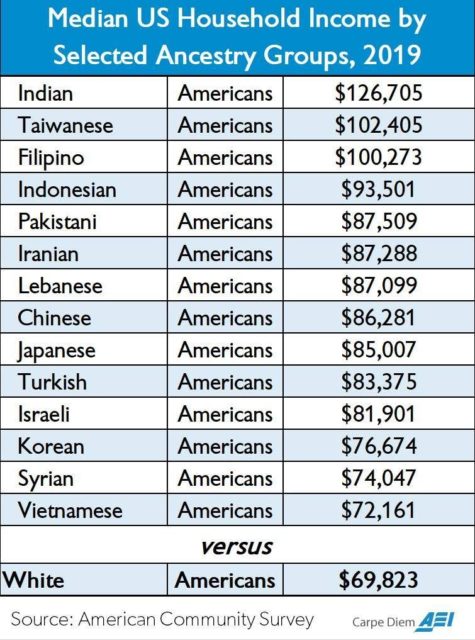To hear some people (especially on social media in these locked-down pandemic days), there has never been a human society that more greatly benefits white heterosexual men and oppresses everyone else like the modern west. Here are some stats from Rav Arora to challenge that claim:
We are frequently told by commentators and theorists on the progressive and liberal Left that we live in a systemically racist and patriarchal society. The belief that Western societies privilege white men and oppress people of color, women, and LGBT citizens is especially popular within academic institutions, legacy media, the entertainment industry, and even sports. However, newly released statistics from the US Department of Labor for the third quarter of 2020 undermine this narrative. Asian women have now surpassed white men in weekly earnings. That trend has been consistent throughout this past year — an unprecedented outcome. Full-time working Asian women earned $1,224 in median weekly earnings in the third quarter of this year compared to $1,122 earned by their white male counterparts. Furthermore, the income gap between both black and Latino men and Asian women is wider than it has ever been. The income gap between white and black women, meanwhile, is much narrower than the gap between their male counterparts.
These outcomes cannot exist in a society suffused with misogyny and racism. As confounding to conventional progressive wisdom as these new figures appear to be, copious research finds that ethnic minorities and women frequently eclipse their white and male counterparts, even when these identities intersect. Several ethnic minority groups consistently out-perform whites in a variety of categories — higher test scores, lower incarceration rates, and longer life expectancies. According to the latest data from the US Census Bureau, over the 12 months covered by the survey, the median household incomes of Syrian Americans ($74,047), Korean Americans ($76,674), Indonesian Americans ($93,501), Taiwanese Americans ($102,405), and Filipino Americans ($100,273) are all significantly higher than that of whites ($69,823). The report also finds substantial economic gains among minority groups. Valerie Wilson at the Economic Policy Institute reports that from 2018 to 2019, Asian and black households had the highest rate of median income growth (10.6 percent and 8.5 percent, respectively) of all main racial groups (although she cautions that overall disparities remain “largely unchanged”). On a longitudinal scale, Hispanics, not whites, had the highest income growth in 2019 relative to the start of the Great Recession in 2007 (although many of these gains have been reversed by the pandemic).
Rapidly rising female economic success is partly a product of higher academic representation. 2019 was the 11th consecutive year in which women earned the majority of doctoral degrees. Women accounted for 57 percent of all students across American colleges in 2018 according to the latest US Department of Education figures and earned the majority of associate’s, bachelor’s, and master’s degrees. According to University of Michigan economist Mark J. Perry, “By overall enrollment in higher education men have been an under-represented minority for the last 40 years.” Sex differences in cognition can help to explain differential performance along gender lines — although men typically perform better on quantitative and visuospatial tasks, several studies have found that on average women perform better in verbal and memory tasks and on reading and writing tests.




